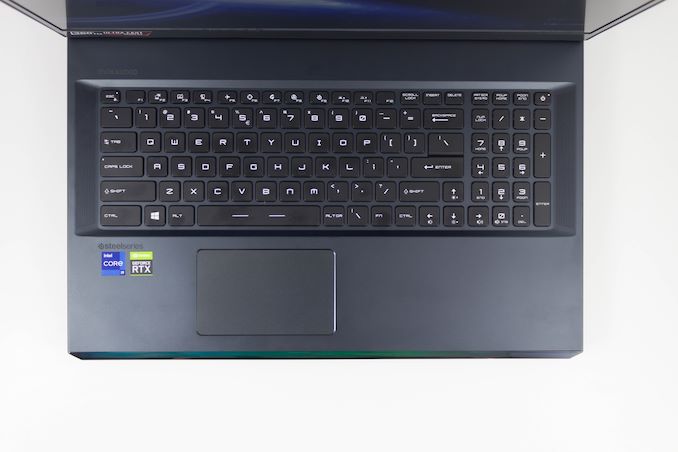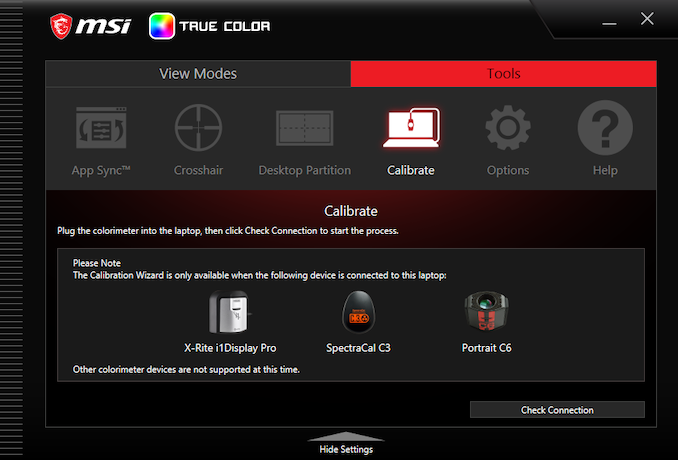Intel Alder Lake-H Core i9-12900HK Review: MSI's Raider GE76 Goes Hybrid
by Brett Howse on January 25, 2022 9:00 AM EST- Posted in
- CPUs
- Intel
- MSI
- Laptops
- Alder Lake
- GE76 Raider
- 12th Gen Core
- Alder Lake-H
The Test Platform: MSI's Raider GE76
For 2022, MSI has not updated the underlying chassis for the new Alder Lake product, and as such our review of the GE76 Raider from 2021 with Tiger Lake does not fundamentally change in terms of chassis design and cooling. This is still a big, relatively heavy desktop-replacement system. It features an aluminum surface where you will be touching it, and a polycarbonate base.
MSI generally builds a very solid product, and for 2022 they have upgraded the cooling with a new phase-change thermal pad which allows them to wick heat away from the processor and GPU quicker, without some of the negatives of a pure-liquid thermal compound and crystallization that can occur.
The system offers a per-key RGB backlit keyboard from SteelSeries. There is a 1080p webcam as well, and the system now offers an AI-based setting to let the system automatically switch the power levels for the user without having to manually do it, although the manual options are still there. MSI has updated their Silent mode to now leverage the microphones on the system to match the noise floor of the room, which lets them extract more power from the processor, and more fan speed, while still being inaudible.
The Raider GE76 offers lots of connectivity, including a single Thunderbolt 4 port, an additional USB Type-C port, and several USB Type-A ports. There is also a SD card reader which is still convenient when uploading from a camera.
The system offers Wi-Fi 6E support thanks to the Killer AX1675 Wi-Fi adapter, and also includes the Killer E3100G 2.5 Gbps Ethernet adapter.
MSI offers a range of display options, with a 1920x1080 144 Hz panel on their least expensive Raider GE76, a 1920x1080 360 Hz panel which is in the sampled unit, a 2560x1440 240 Hz panel, and a 3840x2160 120 Hz offering.
On our Tiger Lake sample we reviewed late last year, the display accuracy was not up to par with typical MSI offerings. Thankfully that appears to have been a one-off, which we do see from time to time even on devices that are hardware calibrated at the factory. MSI does allow you to use a built-in tool to calibrate the display, but you do need a supported colorimeter.
Thanks to Portrait Displays for the use of their Calman software so we can continue to accurately measure displays for our reviews.
As you can see, the color accuracy of this sample is much improved over the Tiger Lake model from last year that we received.
Brightness and Contrast



Grayscale

Gamut

Saturation

Gretag Macbeth

The MSI Raider GE76 is a fantastic test bed for Intel's Alder Lake system, with a powerful cooling system, and a great build quality.




















153 Comments
View All Comments
tkSteveFOX - Wednesday, January 26, 2022 - link
Just a note for Brett here, when you do a laptop review thermals, throttling and noise levels are important things to have in the review.Brett Howse - Wednesday, January 26, 2022 - link
This isn't a laptop review. Please check the link to the GE 76 Raider review we did in September.TheinsanegamerN - Friday, January 28, 2022 - link
*reviews laptop CPU**uses laptop*
*this is not a laptop review*
Whew, anandtech quality ladies and gentlemen! I guess that throttling and thermals are not important in CPU tests either? Or would that get in the way of using RAM to exuse the hideous power draw?
corinthos - Wednesday, January 26, 2022 - link
Whole point of a laptop is portability and using unplugged for a considerable amount of the time. That's why you pay a premium. If the best Intel can do is 3.x hours on battery, this is essentially a desktop alternative/replacement, in which case you get even more for your money just buying a desktop.Brett Howse - Wednesday, January 26, 2022 - link
This is literally a desktop replacement. That's actually a product category for notebooks.Spunjji - Thursday, January 27, 2022 - link
I'm sorry you have to keep replying to comments like this...Spunjji - Thursday, January 27, 2022 - link
For me, those "percentage of no load performance" graphs may have been the most interesting. It certainly shows what Alder Lake can offer when it's being used to the fullest. It doesn't represent a use-case that I'd ever put a laptop to, but it will be very interesting for the sort of user for whom 20 threads in a mobile CPU is less a flashy selling point and more a necessity.Otherwise it's looking as I expected - peak performance is significantly better than the ageing Cezanne platform, sustained performance in a slightly more representative platform remains to be seen. Tiger Lake H was ~25% down on Cezanne in terms of performance/watt in multithreaded loads, so there's certainly potential here for Intel to have caught up and maybe even surpassed that.
abufrejoval - Thursday, January 27, 2022 - link
The least impressive statement in this review is this “Perhaps the most impressive result though is Intel’s Thread Director, which provides very impressive system responsiveness even when the system is at 100% CPU load…”, because to me it sounds either like paid content or lack of reflection.Intel is pushing E-cores as a “must have”, because it’s exclusive to their platform, very much like MMX or AVX-512 back then.
But it’s mostly yet another marketing smoke bomb.
I am convinced you could achieve a very similar gain in responsiveness by emulating the 8 E-cores via the 2 P-cores they replace in terms of silicon real-estate on Alder Lake. What you perceive as a hardware benefit is mostly an OS defect in workload management.
What happens here is that long running batch and latency sensitive interactive workloads are being separated and assigned to hardware partitioned processing pools dependent on whether they are running in the “foreground” or “background”. Doing that in the Windows task manager today, is obviously cumbersome, but writing a tool that prohibits the usage of all CPU cores once workloads are switched to background, should be trivial enough. And to my knowledge even cache partitioning has been part of x86 since Broadwell to ensure that busy background batch tasks won’t flush latency sensitive interactive workloads entirely from them.
Yes, E-cores have been proven to squeeze longer run times out of smartphones or more concurrent session support per Watt in certain cloud servers, because they are designed to be more efficient in in terms of instructions per Watt/h at the price of instructions per unit of time.
But those constraints do not apply to a gaming laptop or most desktop computers. Actually, even on ultra-thin laptops CPU core power consumption is becoming a rather insignificant contributor to overall energy spend, outside of some synthetic fringe cases.
Intel fits 8 E-cores into a similar space for 2 P-cores, so the high-end mobile Alder-Lake parts could just be 8 P cores or 32 E cores or any of the other permutations. And quite obviously you would be able to find workloads with an ideal fit for each, just as you’d also find workloads that violate either performance or efficiency targets on them.
Intel promotes a hardware partitioned compromise between E- and P-cores and then interestingly charges an E-core premium on desktop parts, where collective energy savings on remotely managed always-on volume parts might actually provide an ecological benefit. But I can’t help thinking, that a software solution via “E-core emulation” would deliver more flexibility and adjustable performance on most laptops and workstations and prefer 8P+0E over 6P+4E practically everywhere except server parts.
Bik - Thursday, January 27, 2022 - link
Simple thought will prove this correct: a big task that feels like it bogs down the whole system, will no longer be so if you willing to sacrify some cores for background tasks. The scheduler just isnt smart enough to do that today.There's another thing I notice. When it is true that 8-E cores put up more performance than 2-P cores, Intel claims of silicon real-estate between the two being equal may not be correct. Because if they do, we'll surely have all E-cores cpu for heavy multi-thread work loads. But that didnt, and I doubt, will ever happen.
diediealldie - Thursday, January 27, 2022 - link
oh, they will. There's Sierra Forest AP which consists of 128 e-cores. Intel is not making all e-cores yet since launched platforms are kind of mass-market general-purpose ones which need high ST performance along with good MT performance.